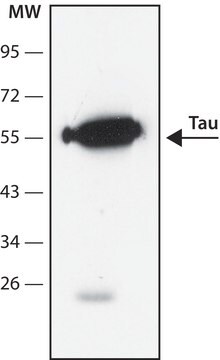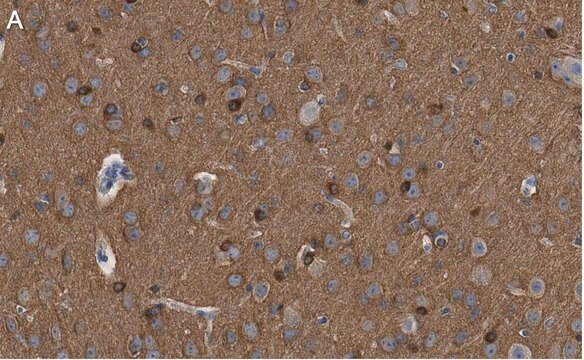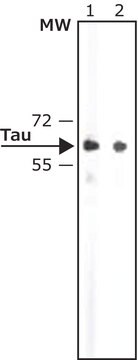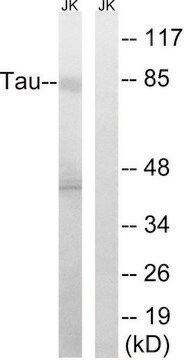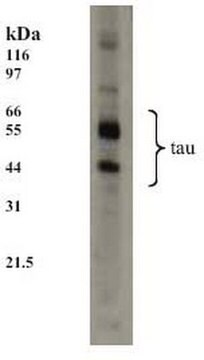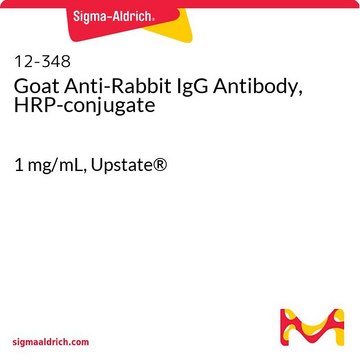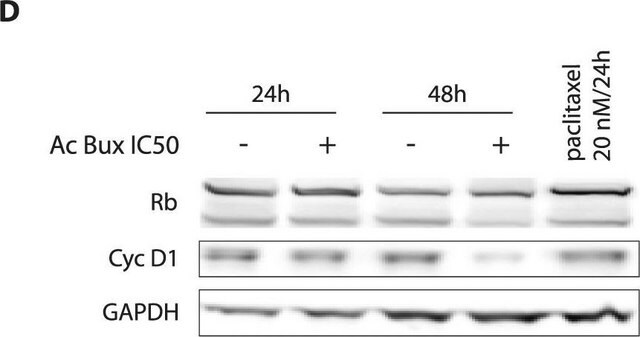おすすめの製品
製品名
Anti-TAU antibody, Rabbit monoclonal, recombinant, expressed in proprietary host, clone SP70, affinity isolated antibody
由来生物
rabbit
品質水準
リコンビナント
expressed in proprietary host
結合体
unconjugated
抗体製品の状態
affinity isolated antibody
抗体製品タイプ
primary antibodies
クローン
SP70, monoclonal
交差性
human (tested)
テクニック
flow cytometry: 1:100
immunohistochemistry: 1:100
アイソタイプ
IgG
UniProtアクセッション番号
輸送温度
wet ice
保管温度
2-8°C
ターゲットの翻訳後修飾
unmodified
遺伝子情報
human ... MAPT(4137)
関連するカテゴリー
詳細
Tau is a neuronal microtubule associated protein found predominantly on axons. The function of rau is to promote tubulin polymerization and stabilize microtubules, but it also serves to link certain signaling pathways to the cytoskeleton. Tau, in its hyperphosphorylated form, is the major component of paired helical filaments (PHF) and neurofibrillary lesions in Alzheimer′s disease (AD) brain. Hyperphosphorylation impairs the microtubule binding function of tau, resulting in the destabilization of microtubules in AD brains, ultimately leading to the degeneration of the affected neurons. Hyperphosphorylated tau is also found in a range of other central nervous system disorders. Numerous serine/threonine kinases, including GSK3 beta, PKA, Cdk5, and casein kinase II can phosphorylate tau. Alternate splicing of tau mRNA and differential phosphorylation contributes to the heterogeneity of Tau.
免疫原
Synthetic peptide corresponding to N-terminus of human tau protein.
特徴および利点
Evaluate our antibodies with complete peace of mind. If the antibody does not perform in your application, we will issue a full credit or replacement antibody. Learn more.
物理的形状
0.1 ml rabbit monoclonal antibody purified by protein A/G in PBS/1% BSA buffer pH 7.6 with less than 0.1% sodium azide.
免責事項
Unless otherwise stated in our catalog or other company documentation accompanying the product(s), our products are intended for research use only and are not to be used for any other purpose, which includes but is not limited to, unauthorized commercial uses, in vitro diagnostic uses, ex vivo or in vivo therapeutic uses or any type of consumption or application to humans or animals.
適切な製品が見つかりませんか。
製品選択ツール.をお試しください
保管分類コード
10 - Combustible liquids
WGK
WGK 2
引火点(°F)
Not applicable
引火点(℃)
Not applicable
適用法令
試験研究用途を考慮した関連法令を主に挙げております。化学物質以外については、一部の情報のみ提供しています。 製品を安全かつ合法的に使用することは、使用者の義務です。最新情報により修正される場合があります。WEBの反映には時間を要することがあるため、適宜SDSをご参照ください。
Jan Code
SAB5500182-100UL:
この製品を見ている人はこちらもチェック
Siwei Chu et al.
npj aging, 8(1), 16-16 (2022-12-17)
Intestinal epithelial cells are critical for gastrointestinal homeostasis. However, their function declines during aging. The aging-related loss of organ performance is largely driven by the increase in senescent cells. To date, the hallmarks and molecular mechanisms related to cellular senescence
ライフサイエンス、有機合成、材料科学、クロマトグラフィー、分析など、あらゆる分野の研究に経験のあるメンバーがおります。.
製品に関するお問い合わせはこちら(テクニカルサービス)